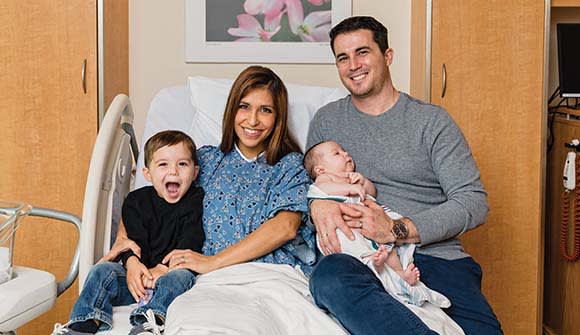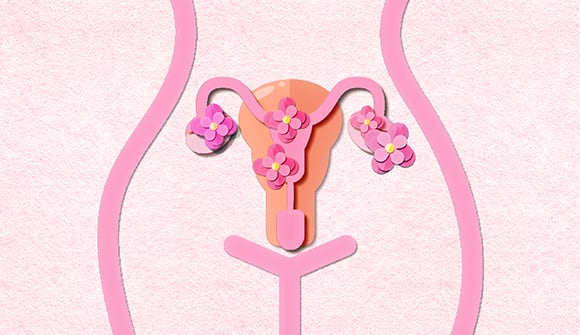'Back to being you'
ERADicating postpartum pain.
Article Date:

On October 30, 2021, Allyson Daley and her husband, Adair, were on the way to Baptist Medical Center South to have their second baby boy. After delivering her first three years prior, Daley thought this one was going to be seamless.
She was admitted to the hospital at 9:58 am and was immediately placed in triage for observation. Her water had broken sometime in the middle of the night, so she had been in labor for several hours.
An ultrasound showed the baby’s heart rate was dipping with each contraction. Daley’s delivery team consisted of two registered nurses (RNs), Nancy Tallyn and Melissa Kremser, and Jose Nieves, MD, obstetrician and gynecologist with Trogolo Obstetrics and Gynecology who delivers at Baptist South. The team feared it was a sign of placental abruption, and they knew they had to act fast.
Placental abruption occurs when the mother’s placenta separates from the inner wall of the uterus before birth. This can deprive the baby of oxygen and nutrients, and in cases like Daley’s, immediate delivery is needed.
Dr. Nieves said Daley wasn’t in active labor even though her water broke. Her cervix was closed, and her unborn son's heart rate was slowing and fluctuating quite a bit. Seeing the baby was already showing signs of distress, the delivery team agreed with proceeding with a cesarean section (C-section).
Daley, who had already had a C-section with her first child, was hoping to have a vaginal birth after cesarean (VBAC) delivery, so she was caught off guard when Dr. Nieves informed her of this change.
“I was not expecting the doctors to come in and tell me I was about to go into an emergency C-section,” Daley recalled.
She was brought straight from triage to the operating room, where she delivered a healthy baby boy named Ethan.
Daley's C-section went smoothly. The delivery team was able to get baby Ethan’s heart rate back to normal by using oxygen and intravenous (IV) fluids, along with having Daley lay on her side.
After the operation, Daley was introduced to Enhanced Recovery After Delivery (ERAD) protocol to manage her pain postpartum. ERAD is a component of Baptist Health’s Enhanced Recovery After Surgery (ERAS) protocol, which is an innovative and evidence-based approach to surgery that can result in improved outcomes for patients. This approach requires changes in the long-established routines before, during and after surgery to help people recover faster.
ERAD guidelines are used to help expecting mothers bounce back more quickly after delivery through medication management, diet and physical activity.
These protocols have proven to:
- Effectively manage pain while limiting the use of narcotic medications.
- Reduce unwanted side effects including nausea, constipation and swelling.
- Enable patients to move, drink and eat more quickly after delivery.
- Help patients feel better faster.
“The doctors and nurses explained to me that they were implementing a new protocol where they limit the mother’s use of narcotics after birth to increase the chances of a better, safer and quicker recovery with fewer complications,” said Daley.
She was eager to try the ERAD protocol because of her experience with her first birth.
“I didn’t want to have to endure all the potential complications and side effects of taking narcotics,” she said. “Sleepy baby, sleepy mommy – I didn’t want that.”
Daley managed her postoperative pain with an acetaminophen and ibuprofen rotation. She felt this allowed her more movement out of her hospital bed.
The morning after surgery, Daley was able to get up and walk down the hallways, something she couldn’t do after the first surgery. She was up and moving nine hours after surgery, and she was shocked she was able to recover so quickly since her body was three years older than when she had her first child.
ERAD protocols are part of the care plan for maternity patients at all Baptist Health birthing hospitals. In addition to emergency C-sections, they are used for planned C-sections and vaginal deliveries. Since ERAD was implemented in late 2020, Baptist Health has seen a 10% decrease in 30-day readmissions and complications.
“I didn’t expect this time around to be as good, and definitely not better, than my first experience,” said Daley. “I honestly didn’t think my body would be able to bounce back after a repeated surgical incision.”
“I was able to be present and focus on my baby instead of worrying about all of the side effects,” she added. “You’re able to get up faster, push yourself faster, get yourself out of the hospital faster, and ultimately get back to being you faster.”
Interested in a faster recovery after delivery? Baptist Health has adopted a new pathway that enhances both the delivery and recovery experience of childbirth. We encourage our patients to play an active role in improving their own outcomes. For more information, visit baptistjax.com/ERAS



